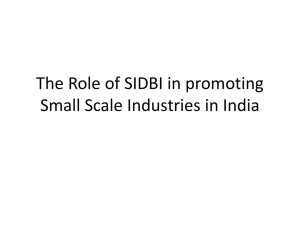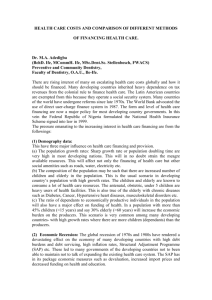lome higher education funding - Association of African Universities
advertisement
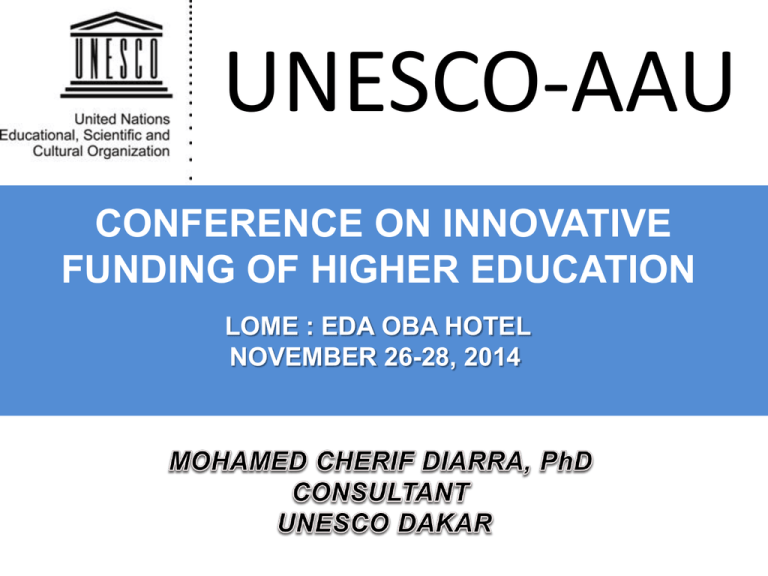
UNESCO-AAU CONFERENCE ON INNOVATIVE FUNDING OF HIGHER EDUCATION LOME : EDA OBA HOTEL NOVEMBER 26-28, 2014 OUTLINE OF THE PRESENTATION I. II. III. IV. V. STATUS OF HIGHER EDUCATION IN AFRICA CURRENT TRENDS OF AFRICAN HIGHER EDUCATION HIGHER EDUCATION FOR GROWTH FINANCING OF HIGHER EDUCATION CHALLENGES/ONCLUSIONS I. STATUS OF HIGHER EDUCATION IN AFRICA • The post independence era African Higher Education’s evolution went through four distinct phases: Stability Growth Crisis and Reforms II. CURRENT TRENDS OF AFRICAN HIGHER EDUCATION i. Enrolments increased from 2.7 million in 1991 to 9.3 in 2006 and 12 m in 2012 that represents a GER of around 10%. ii. Differentiation and diversification (emergence of different types of institutions and surge in various providers: e.g., cross-border provision, public, private, distance and religious, etc.) II. CURRENT TRENDS OF AFRICAN HIGHER EDUCATION iii. Increased access to marginal and non-conventional beneficiaries or non traditional students; however, access is still limited iv. Robust delivery modes such as ICT has contributed, to a certain way, in expanding learning opportunities and democratizing higher education v. Academic and student mobility as well as massive brain drain; most higher education institutions face a critical shortage of faculty and are, in fact, run by junior faculty II. CURRENT TRENDS OF AFRICAN HIGHER EDUCATION vi. Lack of adequate facilities and instructional resources such as books and scientific journals vii. Most higher education institutions focus more on teaching at the expense of research viii. Research is severely underfunded. This underinvestment significantly limits knowledge production ix. Issues of quality, equity, relevance, funding, brain drain, harmonization and promotion of a higher education and research space have emerged as consistent challenges across the whole continent III. HIGHER EDUCATION FOR GROWTH • Higher Education plays a significant role in economic growth in the following manner: • It contributes to the formation of human capital • It creates knowledge that boosts economic growth • It impacts directly or indirectly on all the major characteristics of development: human capital, literacy, health and competiveness • It boosts labour productivity as highly qualified workers are more productive than the less qualified ones III. HIGHER EDUCATION FOR GROWTH • It finally plays a key role in the provision of: the relevant skills for the labour market; the capacity to understand and use global knowledge in science and technology especially for agriculture and the capacity to assess existing information and generate new understanding through research and a much closer working relationship with the productive sectors of the economy IV. FINANCING OF HIGHER EDUCATION • Higher education is a labour and capital intensive enterprise. Thus onerous equipment, infrastructure and costly human capital are required for its operations. • On average, SSA devoted 4.9 % of its Gross Domestic Product (GDP) to higher education in 2012 • On average SSA devoted, in 2012, 15.2% of its recurrent education budget to higher education • So the bulk of the financing of higher education in SSA is borne by the government; other sources are students and their families, development agencies and the private sector. • The government bears all or nearly all of the following categories of costs: IV. FINANCING OF HIGHER EDUCATION • Recurrent costs (Faculty & staff, material and operational, utilities, instructional, and overtime, etc, too high) • Capital costs (fixed costs associated with durable educational inputs such as land, furniture and equipment) incurred by the government • Direct costs comprised of tuition and fees, student living and stipend are incurred by the government and too high • Now the key question is who should pay for higher education in Africa: The government or the government and students and their families? IV. FINANCING OF HIGHER EDUCATION • Should cost recovery thru fee payment be introduced as a way of financing higher education? If yes, how should this be implemented? • Other possible funding sources of higher education are: • Student Loan Schemes (e,g,, Ghana, Kenya, etc,) • • • • • • • • • • Tuition and Fees paid by students Tax levies on business turnover or profits Tax credits Tax on financial transactions Private sector interventions through research grants, merit scholarships, internships, study tours Development agencies’ contributions Donations Research Grants Public Private Partnership (PPP) The funding model of HE in Africa should move from the model implemented at the University of Grenoble, France (current in most Francophone countries), to a model similar to the one implemented at the University of Wisconsin Madison in the United States of America. University of Wisconsin Madison University Joseph Fourier of Grenoble Comparing 2 funding models: Universities of Wisconsin Madison (USA) and Grenoble (France) • Federal Agencies Contracts: 27%; •Madison State Subsidies: 21% • Donations: 20% • Tuition and Fees: 16% • Others: Contracts, etc. : 16% • Government Subsidies: 77% •UJFG University Generated Resources: 15% • Local Communities’ Subsidies: 3% • Others: Contracts, etc. : 5% UWM AND UJFG 2010 BUDGETS’ STRUCTURE FINANCING PUBLIC INTERNAL Tuition and Fees State Contribution Local Government Contribution Initial Provision of the Foundation Academic Fees by semester Resources generated by continuing training Incomes generated by capital outays Conference Center Rental Accomodation nd Housing Sponsored Grants EXTERNAL Funding Agencies Project Fundng Competitive Research Grants Partners Foundation Alumni and Friends’ Contribution Business and Private sector Interests on Investment Funds Initial Allocations Big Projects BANKING ENVIRONMENT University Accounts Crédits Investments Faculty and Personnel Account Management Loans at preferential rates Students Stipends remitted thru banks Loan Schemes FINANCING Characteristics of a bank that provides loans to education • A Bank providing support to Education is a robust system that grants not only loans to students but also to the various activities of the educational system as its mission includes but is not limited to : • Collecting resources from the private sector to fund education ; • Taking over from the government funding responsibilities for specific education projects ; • Granting loans to students ; • Providing research and publication loans ; • Providing funding for equipment rental ; FINANCING Characteristics of a bank that provides loans to education • Financing projects ; • Mobilizing resources and providing services for education needs ; • Mobilizing financial resources for education from donors ; • Analyzing the recurrent costs and cost-benefit of education ; • Financing scientific research and education ; • Support investment in capital outlays and other key university infrastructure. FINANCING . Basic elements of a funding model • A model that guarantees the long-term funding sustainability of the university should comprise : • A trust-fund component with a reputable financial institution that is governed in a flexible manner; • A cost recovery component that is based on equity and means-testing ; • A Loan scheme that is equitable and transparent ; • A donation component that encourages private donors and the private sector to contribute ; FINANCING Basic funding model components • Clear and transparent eligibility criteria and terms and conditions of loans’ reimbursement (interest rates, duration (period of grace), terms of reimbursement, default, etc.); • Efficient management of funds and recovery system ; • Capacity to contribute effectively to the expansion of access and improvement of higher education quality in terms of teaching, learning and research ; • Sustainablity of model and continuous improvemnt. FINANCING : PUBLIC (University of Kaolack/Senegal)-PRIVATE (Bank)-FOUNDATION PARTNERSHIP Université Du Sine Saloum de Kaolack Fondation USSK Banque/ Institution Financière V. SOME CHALLENGES AND CONCLUSIONS 1. Higher education involvement in Research and Development is rather limited 2. Lack of reliable data for informed decision making and planning and monitoring and evaluation 3. Lack of clear, consistent and comprehensive policies governing the role of the private higher education subsector 4. Funding too much dependent on Government allocations and inability to try cost recovery options 5. Rapid expansion of enrolments and very limited infrastructural capacity of higher ed institutions THANK YOU FOR YOUR ATTENTION
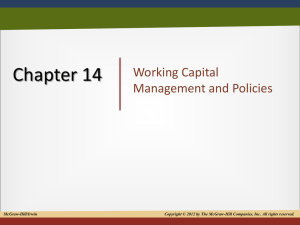
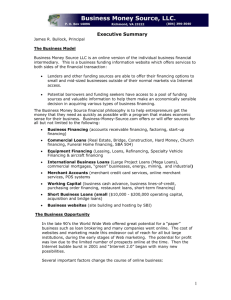



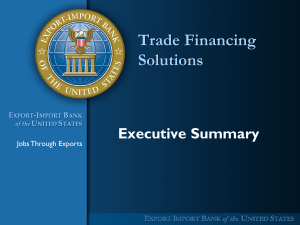



![[07]. Sources of Capital](http://s2.studylib.net/store/data/005505954_1-911bc72c2d6c6cd967dc43c95f25b7bd-300x300.png)
